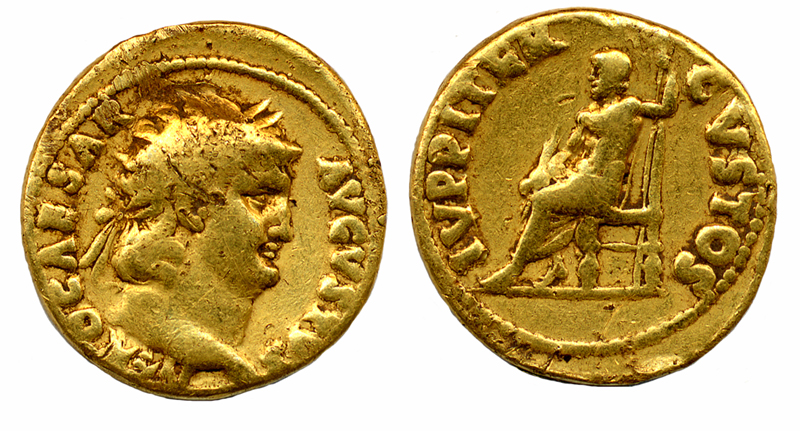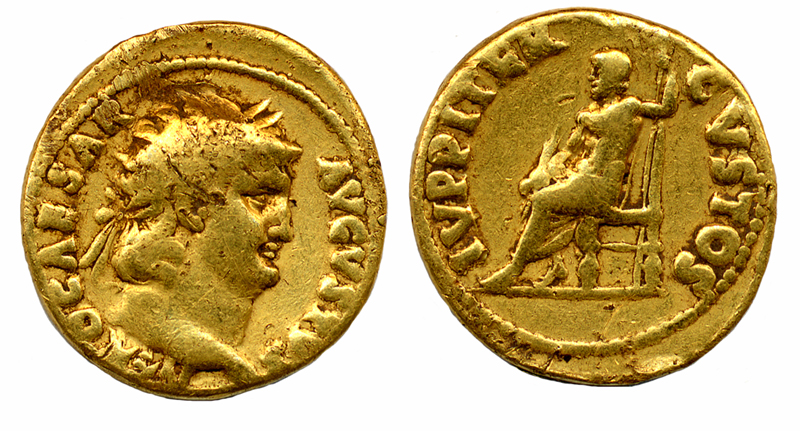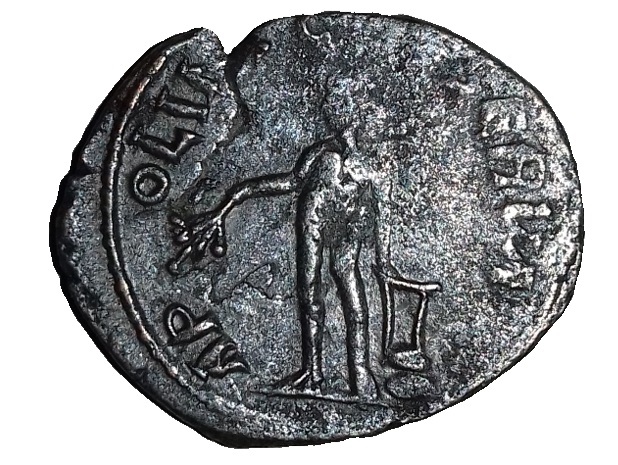Hi everyone, how are you? Today, in this new article, I am going to tell you about 5 Roman Coins in gold. I wrote an article about this a few weeks ago. If you want to read it, it’s available here: 5 Roman Gold Coins. This article is therefore the last of this series where I present to you 5 Roman coins every week. As a result and in the same way as in the previous article “5 Roman Coins in silver”, we are going to do numismatics here. So we will decipher the coins and try to understand the messages they wanted to convey in Roman times. There will therefore be analysis, description and interpretation in this article. Good reading.
First Roman Coin in gold : the aureus of Nero
This first coin is an aureus of Nero. Nero, whose real name is Lucius Domitius Ahenobarbus is a Roman emperor born December 15, 37 AD in Antium. He died on June 9, 68 AD in Rome. His reign began in 54 AD. At that time, Nero ruled with the help of many advisers, including his mother and Burrus. The beginning of his reign took place in good conditions, without major problems and without major mistakes made on his part. Subsequently, Britannicus who would then reach the majority was to take power. Indeed, he was the legitimate son of Claudius, which was not the case with Nero. This denarius therefore had him assassinated in order to remain emperor.
A few years later, Nero had his mother murdered. As a result of this assassination, Nero’s reign turned sour and Nero began to show himself worse and worse (although he already had a high level before). As a result, he had several members of his family executed, he accused the Christian community following the fire in Rome in 64 AD and made himself more and more enemies among the people as well as among his relatives and friends. politicians. Following this gradual decline of his power, he committed suicide by stabbing himself in the throat on June 9, 68 AD. Thus, the reign of one of the emperors considered to be among the most cruel came to an end.
This gold coin weighs 7.10 grams for 19 mm in diameter. On its obverse, we can see the bust of Nero, surrounded by the captions “NERON CAESAR AVGVSTVS” (Nero, Caesar, Augustus). On its lapel, Jupiter can be seen seated on a throne, holding a javelin in his left hand and a thunderbolt in his right hand. The inscribed captions are “IVPPITER CVSTOS (Guardian Jupiter).
This coin was therefore minted, as the legends on the obverse indicate, when Nero was “August” emperor and had the title of “Caesar”.
Second Roman Coin in gold : the aureus of Domitian

This second coin is an aureus of Domitian. Domitian, whose real name is Titus Flavius Domitianus is a Roman emperor born October 24, 51 AD in Rome. He died in his hometown on September 18, 96 AD. Domitian was part of the Flavian dynasty and was the eleventh emperor to reign. He ruled from 81 to 96 AD. He succeeded Titus and Nerva will be his successor. During his reign, he made campaigns as in Brittany but also wars against the Germans and the Dacians. In addition, he launched a program to rebuild Rome which had been affected by several fires and revalued the coin. Indeed, the weight of the deniers went from 2.87g to 3.26g then from 3.26g to 3.04g. He died in 96 AD assassinated by members of his court.
This gold coin weighs 7.35 grams for 19 mm in diameter. On its obverse, we can see the bust of Domitian, surrounded by the captions “IMP CAESAR DOMITIANVS AVGVTVS” (The emperor, Caesar, Domitian, Augustus). On his lapel, we can see Minerva standing, brandishing a javelin in the right hand and holding a shield in the left hand. The inscribed captions are “IMP XI COS XII CENS PPP” (Eleventh imperial greeting, Consul for the twelfth time, perpetual censor, father of the country).
This coin was therefore minted when Domitian was Consul for the twelfth time. However, it was in 87 AD. We can therefore deduce the date of minting of this coin.
Third Roman Coin in gold : the aureus of Septimius Severus
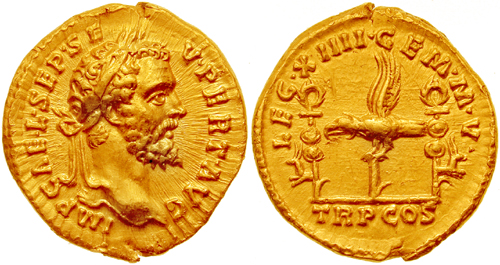
This third coin is an aureurs de Septimius Severus. Septimius Severus, whose real name is Lucius Septimius Severus Pertinax is a Roman emperor born April 11, 146 AD in Leptis Magna (city of the Republic of Carthage) and died February 4, 211 AD in Eboracum (current city of York). Before becoming emperor, he had a military career in commanding the legions in Illyria but also a political career by being in particular “legate”.
Septimius Severus becomes emperor in 193 AD and quickly undertakes a march on Rome, accompanied by several legions. During his first years of reign, he got rid of these competitors: Ddius Julianus, Pescennius Niger and Clodius Albinus. Subsequently, he consolidated his right to be emperor by proclaiming himself the son of Marcus Aurelius. He also strengthens the power for his sons Caracalla and Geta and for his wife Julia Domna by giving them the titles of “Caesar” and “Augusta”, “Caesar” and “Augusta” respectively. Finally, Severus devoted almost all of the remaining years of his reign to the defense of the Empire. Thus, it consolidated the borders in particular vis-a-vis Parthians and in Africa and especially in Brittany. Indeed, he left Rome in 208 AD for what is now Scotland and remained there until the end of his life in 211 when he died in York.
This gold coin weighs 7.25 grams for 19 mm in diameter. On its obverse, we can see the bust of Septimius Severus surrounded by the captions “IMP CAE L SEP SEV PERT AVG” (The Emperor, Caesar, Lucius Septimius Severus Pertinax, Augustus). On its reverse, we can see an eagle, wings out, surrounded by two military ensigns. The inscribed captions are “LEG XIIII GEMMV TRP COS” (Legion XIIII [14], Gemina Martia Victrix, endowed with the tribunitian power, consul).
This coin (like the deniers of the legions of Marcus Antonius) is an aureus struck for the fourteenth legion. This legion was created under Caesar and served on numerous occasions under him. The emblem of the Fourteenth Legion was Capricorn. This legion was one of those marching alongside Septimius Severus at the start of his reign. Also, this denarius became “Consul” for the first time, as indicated on the coin in 190 AD and received the “Tribunitian Power” in 193 AD. We can therefore assume that this coin dates from the beginning of his reign to be around 193 AD.
Fourth Roman Coin in gold : the solidus of Valentinian II
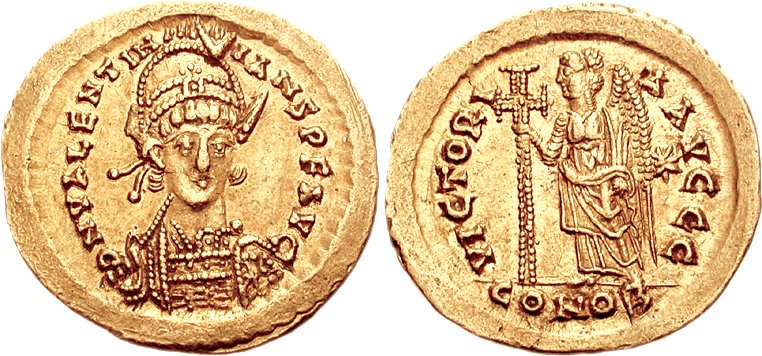
This fourth coin is a solidus of Valentinian II. Valentinian II, whose real name is Flavius Valentinianus, is a Roman emperor born in 371 AD and died in 392 AD. He was emperor from 375 AD. He was therefore 4 years old which is extremely young for an emperor. As a result, he finds himself under the tutelage of Justine: his mother. Subsequently, in 387 AD, the young emperor was driven out of Rome by Maxime who then took control of the city of seven hills. So, with the help of Theodosius I, he managed to return and regain Vienna in AD 392. He was subsequently assassinated there by General Arbogast who then proclaimed Eugene as emperor.
This gold coin weighs 4.41 grams for 22 mm in diameter. On its obverse, we can see the armored bust of Valentinian II from the front, holding a spear resting on his right shoulder with his right hand. Also, we find the legends “DN VALENTINIANVS P F AVG” (Our Lord Valentinian, pious and happy august). On its reverse, we can see the Victory standing, holding a cross. The inscribed captions are “VICTORIA AVGGG” (The victory of the Augustes).
This coin was therefore struck when Valentinian II was victorious. Maybe when he got back to Vienna? This coin would date from 392 AD.
Fifth Roman Coin in gold : the solidus of Avitus

This fifth coin is a Solidus of Avitus. Avitus, real name Marcus Maecilius Flavius Eparchius Avitus, is a Western Roman emperor who was born around AD 395 and died around AD 456. He reigned from 455 to 456 AD, a little over a year. Before his reign, he restored peace with the Visigoths, he was in the military and carried out several campaigns. He then became in 437, magister militum and also helped to stop the siege of Narbo. He then became praefectus praetorio in 439. Later, he was magister millitum by the current emperor at that time: Petronius Maximus, and was sent on a diplomatic mission to the king of the Visigoths, Theodoric II.
It was at this time that Genséric ended the reign of Petronius Maximus. Thus, it was in 455 that he was named emperor. But because of his Gallic origins, he struggled to be accepted as emperor by the inhabitants of Italy. Following the failure of his campaigns against the Vandals and the blockade of Rome by the latter, his reign becomes difficult. As a result, a coup d’etat is created. He is therefore forced to flee to Arles. There, he assembles a small army with the men he has on hand and returns to Italy in an attempt to regain control but loses at Plaisance. He was taken prisoner and the title of Bishop of Plaisance was offered to him, but very quickly the Senate decided to decline this proposal.
Subsequently, he was afraid of being assassinated and therefore returned to Gaul, but died on the trip under mysterious conditions. He was reportedly buried in the town of Brioude, at the Saint-Julien altar. During his life, he owned several homes, land and a lake near the present city of Clermont-Ferrand.
This gold coin weighs 4.45 grams for 21 mm in diameter. On its obverse, we can see the bust of Avitus, surrounded by the captions “DN AVITVS PERP F AVG” (Our lord Avitus, perpetually son of august). On his lapel, Avitus can be seen standing, holding a scepter surmounted by a cross in his right hand and a globe with a Victory above it in his left hand. The inscribed captions are “VICTORIA AVGGG” (The victory of the Augustes).
This solidus seems, as its reverse indicates, struck when the emperor was victorious.
There you go, this article is now complete. Hope you liked it and discovered new things. Also, feel free to tell me in the comments space what topic you would like me to cover for a future article. Regarding this one, we will be interested in the Roman dynasties with “The Julio-Claudians”. See you next week !
Receive my free book Around the Roman Coin here

